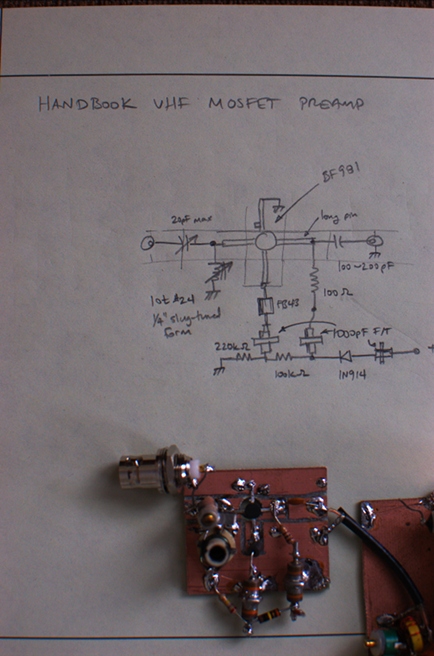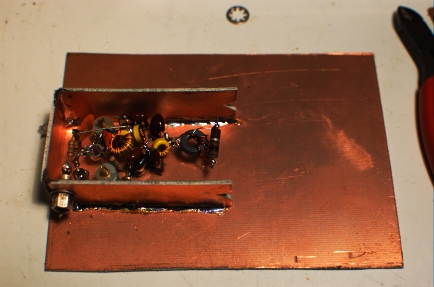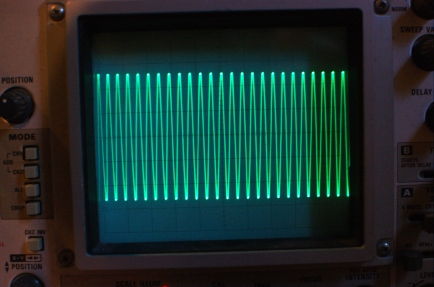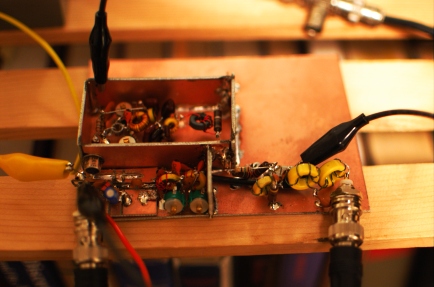Built a little low-noise amplifier for the RX converter today using one of the BF981s I received the other day. The design is based on the dual-gate MOSFET VHF preamp in the 1993 ARRL Handbook. My local noise level was too high to credibly optimize the match on the beacon alone. But, it did improve my ability to hear it on the 10-meter dipole.
Archive for the ‘engineering’ category
50-MHz RX LNA (Day 2)
May 1st, 2010Knitting Electronics
April 29th, 2010Sarah is a knitter. She started when I was in graduate school. It was a sort of support group for all of the other wives and girlfriends of grad students, postdocs, and faculty. When we moved, several others also moved to various places and the group keeps in touch loosely via e-mail and (electronic) social networks. The unofficial leader of their group moved to Switzerland while her husband was on sabatical there this year. Knitting is to her what building and repairing electronics is to me—she always has multiple projects, buys more yarn than she needs for a project, etc, etc.
Sarah remarked yesterday that her friend in Switzerland had e-mailed an urgent plea for suggestions on some eight different projects. “Gee, ” I thought, “this sounds like my problem.” I was reminded also that one of my SuperDARN colleagues calls the portion of a radar build in which we construct the phasing cables and wire antennas “the knitting circle.” Everyone sits around with a sharp knife, connectors, crimpers, or a solder iron, making up cables and chatting like a group of knitters. Let’s extend this a little farther…
It occurred to me that it is socially acceptable to knit in coffee shops, during lectures, on mass transit, on airplanes (politically-incorrect jokes about knitting Afghans aside), and even during church services. What are the barriers to knitting electronics in public? A few thoughts came to mind…
- Soldering is incompatible with the public sphere.
- Knitting is inherently tidy by virtue of the yarn being continuous, unlike discrete components which are tiny and hard to contain.
- Knitting is socially “understood” whereas building electronics in public might elicit the bomb squad.
- Most of my projects (e.g., TS-930) are too heavy to schlep around.
Ok. That settles it. I guess I’ll have to settle for drawing block diagrams in my little black notebook.
Candy Deliveries
April 28th, 2010I’m fond of telling visitors to our home that I stock more electronic parts than a RadioShack. That used to mean something. But, I digress.
I took delivery of a used Cushcraft A50-3S 6-meter Yagi antenna yesterday (tnx, W8RU). And, today a package arrived from Dan’s Small Parts and Kits. Dan’s is a good place to pick up some unusal semiconductors. In fact, he probably has the largest stock of thru-hole dual-gate MOSFETs left in the world. I ordered a lifetime supply of piston trimmers and BF981s, in addition to a few other odds and ends for my VHF+ adventure. As I use some of this stuff, it will get written up here—reminds me, I owe a schematic for the 6-meter RX converter.
Tomorrow, I expect to receive the remaining components (mostly miscellaneous carbon composition resistors) to build the TX section of the 6-meter converter from Mouser, in addition to some TS-930 spare parts purchased to make the shipping worthwhile. Enough shopping! It’s time to build some stuff.
50-MHz RX converter (Day 1)
April 26th, 2010This is going to be short with a few pictures. The schematics will follow once I get things into a final form. As anyone who follows the blog knows, I have recently acquired a VHF habit. I have endeavored to do this at reasonable cost. Thus, the “transverters” series begins…
One of the first things Dad won at a hamfest after we got licensed was the 1993 ARRL Handbook. Between us, we’ve read the thing cover-to-cover a few times. OK, that was mostly me. I ended up swiping it at some point a few years ago and I still read it now and then. One of the objects of my interest since the very beginning has been the chapter full of VHF projects. I was always frustrated as a new ham that the 6-meter transmitting converter article was not a complete transverter. This is my story of building a 6-meter transverter based on the transmitting converter in the 1993 ARRL Handbook.
The Handbook calls for a 22-MHz LO, resulting in a 28-MHz IF. I elected a 24-MHz LO using an inexpensive (< $1) computer crystal instead of the $15-$25 custom crystal. We’re talking most of the cost of the project going into the crystal. The 24-MHz LO put the IF at 26 MHz. For the non-engineer (or non-ham) readers who’ve made it this far, this is just arithmetic: 22+28=24+26=50. 26 MHz (28 MHz) is the frequency to which we are tuning our existing receiver, 50 MHz is where we wish to receive, and 24 MHz (22 MHz) is the oscillator frequency we need to mix with the 50 MHz signal make it show up at our receiver (26 or 28 MHz). The designs are functionally equivalent except for some tighter filtering requirements when the IF and LO move closer together. No big deal for this design, though.
After noting two important failures in the wiring (before the walls in the photo above were installed), the oscillator jumped to life and I tuned it for maximum smoke (peaked it).
As an aside, this picture reminds me that if I had a modern digital oscilloscope, I could have a soft copy saved to insert into this post. Ah, analog!
While the LO chain was straight out of the ARRL Handbook, except for the 24-MHz crystal, the RX strip was completely of my design. I don’t have the schematic in electronic (or paper, for that matter) form, yet. But, it consists of a 2-resonator preselector filter (lifted from Experimental Methods in RF Design), a TUF-3 diode ring mixer, and a diplexer mixer IF-side termination (from the 144-/220-MHz transverter article in the same edition of the Handbook). I had an SGA4586 MMIC amplifier board soldered-up from another project; so, I tacked that on the front end. This final step was mostly because I was in a hurry to meet the weekly landline sked with my folks.
I hooked the whole mess up to my 10-meter dipole and FT-840 to have my first tune about 6 meters. The preamp did not appear to work, so I shunted it. (This was not surprising since I just found it on my bench in some unknown and unrecorded state. Plan to build something better.) Last night, thunderstorms were in the area, so I didn’t want to leave it connected for long. I had cleverly shunted both the preamp and the preselector, so I was getting a fair bit of static crashes from the 2 MHz image, as well. But, I heard the W3APL beacon on 50.064 (actually 26.0725…the LO is not exactly on 24.000 MHz).
This morning, I realized my error and put the preselector in line, shunting only the preamp. I peaked the preselector on the beacon signal. It is handy to have a local beacon. If I ever live somewhere without them, I think I’d almost just install a set of them for the sole purpose of helping experimenters align their gear with minimal test equipment. Although, the HP8640B is reasonably-priced, even with option 002. Should probably pick one up at some point.
More on this adventure to follow…
Repairs
April 17th, 2010Something noteworthy that I should have added to the previous post, but that could deserve it’s own: I’m all caught up on radio repairs, which means I’ll have more time to operate! And, I can return to the business of building transverters (or repairing test equipment—Dad’s Tek 464 and my HP 8405A). NN3W told me yesterday he’d give me $10 to repair his TS-930S when I got done with mine. I told him I wouldn’t take the screws out of the case for that…
TS-930S repair notes (17 April 2010)
April 17th, 2010This is just a quick note summarizing my repair of the 5-million S/N TS-930S. Both the fragile MRF-485 drivers and the hardy MRF-422 finals were toast. The power supply pass transistors (2N5886s) were also dead. Two electrolytic capacitors in the PA bias network over-voltaged and exploded. Original cause unknown, but certainly exacerbated by a slipped probe when setting the driver bias previously.
I almost wrote this one off and parted-out the goodies from this radio to finance a new radio. But, when I saw the price of a used Orion or properly-configured K3/100, I realized I could repair this one a lot of times and save my money for my newly-acquired VHF+ habit and the eventual, mythical, first tower.
To begin with, I got the power supply working again with my last set of spare 2N5886s. Should buy a half-dozen more of these to keep on-hand. With the PA disconnected, I set the 28B line at 28.5 volts.
Now for the big job: I tore-down the entire PA board, cleaned it, and cleaned the heatsink. Replaced all of the bias resistors with new carbon composition types from Mouser. Replaced the MC1723 regulator IC in the PA bias with LM723. Replaced all electrolytic capacitors in PA. Replaced drivers with MRF-485MP-HB (matched-pair, high-beta) from RF Parts. Used all-new mounting hardware and mica insulators. Replaced finals with 2SC2510A-MP, also from RF Parts. This part is essentially the Toshiba version of the Motorola MRF-422, but at about 1/2 of the price and a little higher beta. Yes, I know the higher beta may cause instability if run at full output or poorer IM if run at lower power. But, I was in a thrifty and experimental state of mind. Performed the PA bias alignment according to the Service Manual.
I fired the radio up into a dummy load on my bench (which is in the basement, two floors away from the shack—note to self: this was a dumb idea). No output on CW. Check ALC—pegged. Check Ic meter (PA collector current)—pegged. The radio wasn’t groaning (or popping/stinking) like a circuit drawing too much current. So, I figured it was in the current transducer circuit. Righto! This circuit contains a beefy 0.5-ohm cement resistor bolted to the power supply heatsink—basically they use the voltage drop across this resistor to estimate the current. One of the sensor leads from this resistor read 0 volts. After a good deal of tracing and troubleshooting, including inductors on the power supply board, I tracked it down to a bad trace near the connector on the power supply board, which was easily shorted with a small piece of wire.
That fixed it right up. The radio made slightly more than 100 watts on CW and about 55 in TUNE mode, just as it ought to. Next, I noted that the PA and P/S fans did not come on while I was transmitting, even though the heatsinks had become appreciably warm to the touch. So, I hard-wired the P/S fan to the 8-volt line in the fan case (see the W6NL mods for more details). In the case of the PA fan, I hard-wired a 7812 regulator (with an appropriate capacitor–0.68 uF/50 volts) to the 28B line on the power supply and brought 12 volts out to the fan. So, both of the fans run all of the time now, which is a better arrangement. Plus, I now have a regulated 12-volt source easily accessible inside the top portion of the radio.
I put the radio back together and took it up to the shack. Made a few QSOs in the Michigan QSO Party and it seemed to be working great. However, I did hear a little popping on the second radio. I don’t know if this is a symptom of poor isolation in my station (need to follow the K9YC directives for SO2R bonding) or a power spike or IM problem on the radio. Probably should make some measurements on those things.
TS-930S PLL
March 2nd, 2010One of my TS-930s (2-million S/N) has always been a little touchy when it comes to the synthesizer PLLs. A while back, I put new electrolytic capacitors in the power supply because the old ones were drying out, reducing the regulation. After setting the supply voltage back to 28.5 volts, I noticed the PLL wouldn’t lock (indicated by the letters PL.L on the display—this radio has the PIEXX digital board upgrade) on any band.
Thanks to KA5IPF, whose expertise has been invaluable to me as a Kenwood owner, I learned that this was probably due to the master heterodyne oscillator not oscillating since it affected all bands. I tweaked L77 on the signal unit (front corner of the radio behind the PITCH/AF TUNE knob) until the oscillator dropped out, then backed up until it came back and dropped again. Then, I split the difference, just as Clif recommended. I had the radio on 40 CW at the time. And, it was so touchy that when I changed bands, it would unlock again. So, I got it dialed in on 40 CW and left it. This was fine since I was operating domestic contests at the time and having a radio on 40 all the time from the Midwest is usually a good idea.
But, now that I’ve moved to the East Coast where DX contests are the name of the game, I’ve decided that it would be a good idea if the radio were more frequency-agile. I pulled it apart last night and got to the PLL board, which is notorious for cold solder joints. (Is it a bad thing when you “just know” how to get to any circuit in your radio in 10 minutes or less? Probably.) I didn’t see anything that looked visibly cold, but I went around and reflowed a bunch of joints and, fresh off my success with the TS-700, I cleaned all the connectors. Then, I repeated the L77 master heterodyne oscillator adjustment.
It seems to be working now, although I need to give it a good run in a contest to be sure. This leaves only the radio that eats expensive transistors like popcorn to be repaired…
Principles
March 2nd, 2010Saw a talk by John C. Knight of the University of Virginia yesterday: The Use of Rigorous Arguments in Engineering. Basically, instead of employing standards to ensure interoperability and reliability of complex systems, he proposes using a (tree-like) structure of justifications that is specific to the project. These two statements remained with me:
An argument without evidence is unfounded.
Evidence without an argument is unexplained.
Although it sounds obvious, we engineers and scientists occasionally forget these principles in the rush to write-up our work.
Epic Snow
February 7th, 2010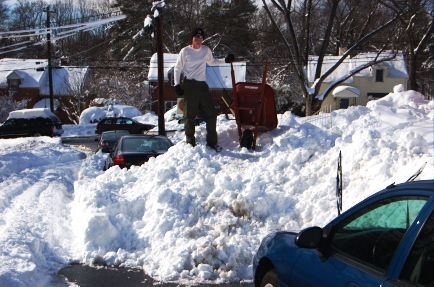
We got some snow this weekend. Although it was an average winter storm for my friends in Minnesota, it is a snow-removal headache of epic proportions for the DC area. With a little effort and the right tools, we cleared our cars out this afternoon: better life through engineering. (I was tempted to caption the picture above after the Troy McClure film Man vs Nature: the Road to Victory. But, you have this instead.) The plow came through later and it only took 15-20 minutes to clean up the rest and were out to get pizza.
i is for intuitive
February 6th, 2010
Sarah got me an iPod Touch for Christmas, which I am enjoying considerably. One of the things that struck me about it when I first opened the package was that it came with no instructions. I marveled briefly that it was so intuitive.
That thought perished from my mind until I was at my mechanic’s shop getting the oil changed in the car on Wednesday. The shop manager was telling me how he had given his teenage daughter an iPod Touch for Christmas and they couldn’t figure out how to use it at first.
What is the difference between our experiences? How does Apple get away with not including instructions? I just found it interesting from a design perspective…
